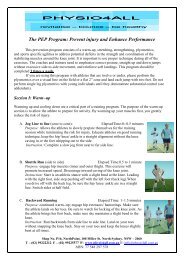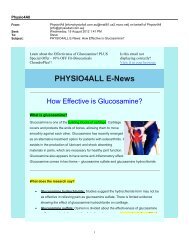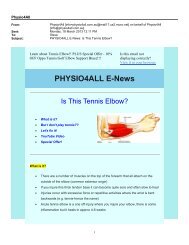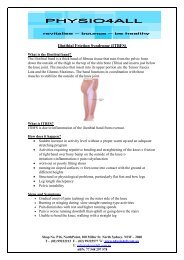SLAP Lesion injury to the should... - PHYSIO4All
SLAP Lesion injury to the should... - PHYSIO4All
SLAP Lesion injury to the should... - PHYSIO4All
You also want an ePaper? Increase the reach of your titles
YUMPU automatically turns print PDFs into web optimized ePapers that Google loves.
PHYSIO4ALL<br />
revitalise – bounce – be healthy<br />
<strong>SLAP</strong> <strong>Lesion</strong> <strong>injury</strong> <strong>to</strong> <strong>the</strong> <strong>should</strong>er<br />
Ana<strong>to</strong>my<br />
The <strong>should</strong>er joint is very complex and highly<br />
unstable. Consider <strong>the</strong> <strong>should</strong>er as a ball and<br />
socket joint where <strong>the</strong> ball is three times larger<br />
than <strong>the</strong> socket. The socket is surrounded by a<br />
firm and rubbery material known as <strong>the</strong> labrum.<br />
The labrum offers greater contact between <strong>the</strong><br />
socket and <strong>the</strong> ball thus increasing <strong>the</strong> stability of<br />
<strong>the</strong> <strong>should</strong>er joint. The labrum also serves as an<br />
attachment point <strong>to</strong> joint ligaments, capsule and<br />
<strong>the</strong> biceps tendon.<br />
Injury<br />
The most common mechanisms of <strong>injury</strong> <strong>to</strong> <strong>the</strong> glenoid labrum are repetitive overhead<br />
throwing activities, an excessive forceful pulling stress (e.g. a person may suddenly grab<br />
a falling heavy object or have <strong>the</strong>ir arm pulled forcefully) or a compressive force applied<br />
<strong>to</strong> <strong>the</strong> <strong>should</strong>er joint (e.g. a fall on <strong>the</strong> outstretched hand).<br />
Injury <strong>to</strong> <strong>the</strong> labrum can also be as a result of degeneration <strong>to</strong> <strong>the</strong> joint from past<br />
instability and longstanding rota<strong>to</strong>r cuff problems that have not been properly addressed.<br />
Labral injuries are divided in<strong>to</strong>;<br />
<strong>SLAP</strong> lesions - <strong>the</strong> tear is located in <strong>the</strong> <strong>to</strong>p portion of <strong>the</strong> labrum at <strong>the</strong> front of <strong>the</strong><br />
biceps tendon <strong>to</strong> <strong>the</strong> back of <strong>the</strong> joint socket.<br />
Non-<strong>SLAP</strong> lesions - <strong>the</strong> tear tends <strong>to</strong> be unstable and degenerative in nature.<br />
Signs and Symp<strong>to</strong>ms<br />
• Poorly localized pain in and around <strong>the</strong> <strong>should</strong>er exacerbated with overhead and<br />
twisting tasks.<br />
• “Popping”, “clicking” or catching sensation with overhead and twisting tasks.<br />
• Painful <strong>should</strong>er with heavy lifting and biceps contraction.<br />
Diagnosis<br />
<strong>SLAP</strong> lesions are difficult <strong>to</strong> diagnose by physical exam since <strong>the</strong> tests utilized are only<br />
somewhat accurate. MRI is sometimes not very accurate, but <strong>to</strong> enhance <strong>the</strong> ability <strong>to</strong><br />
detect a tear with MRI, a dye can be injected in<strong>to</strong> <strong>the</strong> <strong>should</strong>er prior <strong>to</strong> <strong>the</strong> MRI. This is<br />
called a MRI arthrogram. However <strong>the</strong> most accurate diagnostic <strong>to</strong>ol for a <strong>SLAP</strong> lesion is<br />
arthroscopy.<br />
Shop No. P16, NorthPoint, 100 Miller St. North Sydney. NSW – 2060<br />
T – (02) 99222212 F – (02) 99225577 W: www.physio4all.com.au<br />
E: info@physio4all.com.au<br />
ABN: 77 548 297 578
PHYSIO4ALL<br />
revitalise – bounce – be healthy<br />
Management<br />
Most patients with a suspected labral <strong>injury</strong> <strong>should</strong> undergo a period of conservative<br />
management prior <strong>to</strong> surgical intervention.<br />
Physio<strong>the</strong>rapy will consist of;<br />
• Early Pain reduction with relative rest, ice, anti-inflamma<strong>to</strong>ry medication and<br />
electro<strong>the</strong>rapeutic modalities as needed.<br />
• Gentle joint mobilizations and range of motion exercises outside <strong>the</strong> painful range<br />
<strong>to</strong> regain joint mobility.<br />
• Streng<strong>the</strong>ning/stability exercises <strong>to</strong> create simultaneous activation of <strong>should</strong>er<br />
musculature and optimal <strong>should</strong>er blade function<br />
• Return <strong>to</strong> sport and plyometric training<br />
Surgery and pos<strong>to</strong>perative rehabilitation<br />
Conservative management of an unstable <strong>SLAP</strong> lesion is often unsuccessful. The surgical<br />
treatment of a <strong>SLAP</strong> lesion involves repair of <strong>the</strong> <strong>to</strong>rn labrum with sutures down <strong>to</strong> <strong>the</strong><br />
bone where it has been partially <strong>to</strong>rn. This is often performed arthroscopically.<br />
The pos<strong>to</strong>perative rehabilitation involves some form of protected range of motion for 3<br />
weeks. By 6 weeks after surgery, you <strong>should</strong> be nearing full range of motion. Light<br />
streng<strong>the</strong>ning can begin at 3 weeks after surgery and return <strong>to</strong> sports <strong>should</strong><br />
occur around 4 months after surgery. For athletes involved in throwing sports, this will<br />
often be closer <strong>to</strong> 6 months.<br />
References<br />
Donald F. D'Alessandro, MD*; James E. Fleischli, MDt;<br />
Patrick M. Connor, MD* Superior Labral <strong>Lesion</strong>s: Diagnosis and Management, Journal of Athletic<br />
Training 2000;35(3):286-292<br />
Brukner, P., Khan, K: Clinical Sports Medicine rd Ed., McGraw Hill Companies 2007.<br />
Understanding <strong>SLAP</strong> lesions, Sports medicine connection (Spring Issue)<br />
Image taken from;<br />
http://www.eorthopod.com/images/ContentImages/<strong>should</strong>er/biceps_tendonitis/<strong>should</strong>er_biceps_tendonitis_<br />
causes03.jpg<br />
Shop No. P16, NorthPoint, 100 Miller St. North Sydney. NSW – 2060<br />
T – (02) 99222212 F – (02) 99225577 W: www.physio4all.com.au<br />
E: info@physio4all.com.au<br />
ABN: 77 548 297 578










